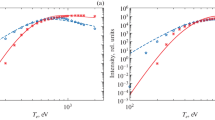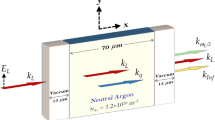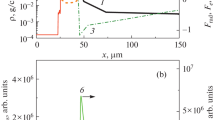Abstract
The spectral character of X-ray emitted from laser-irradiated gold disk is studied by using the one-dimensional non-LTE multigroup radiation transport hydrodynamics code RDMG. The applicability of the “three-temperature” model in which the radiation is described with thermal conduction approximation is checked. The simulation results show that the X-ray emitted from the laser-produced gold plasm is in non-LTE, and that the atom model has significant effect on the structure of X-ray spectrum. However, the plasma states, laser absorption efficiency and X-ray conversion efficiency, which are calculated with the “three-temperature” model, are almost the same as those with non-LTE multigroup radiation transport model. This fact indicates that the “three-temperature” model can be used to study plasma states and the energy distributions produced by a laser-irradiated high-Z target. This is meaningful to the 2-D or 3-D simulation.
Similar content being viewed by others
References
The Plasma Physics Subject Advance Stratagem Research Group, Nuclear Fusion and Low-temperature Plasma—Challenge and Strategy Facing the 21st Century, Beijing: Science Press, 2004, 3–4. 02
Lindl, J., Development of the indirect-drive approach to inertial confinement fusion and the target physics basis for ignition and gain. Phys. Plasmas, 1995, 2(11): 3933–4023.
Lindl, J., The physics basis for ignition using indirect-drive targets on the national ignition facility, Phys. Plasmas, 2004, 11(2): 339–491.
Chang Teiqiang et al., Laser-plasma Interactions and Laser Fusion, Changsha: Hunnan Science and Technology Press, 1991, 234–289, 438–447.
Rosen, M. D., Phillion, W. D., Rupert, V. C. et al., The interaction of 1.06 μm laser radiation with high Z disk targets, Phys. Fluids, 1979, 22(10): 2020–2031.
Mead, W. C., Campbell, E. M., Estabrook, K. G. et al., Laser Irradiation of Disk Targets at 0.53 μm wavelength, Phys. Fluids, 1983, 26(8): 2316–2331.
Goldstone, P. D., Goldman, S. R., Mend, W. C. et al., Dynamics of high-Z plasmas produced by a short-wavelength laser, Phys. Rev. Lett., 1987, 59(1):56–59.
Takabe, H., Yamanaka, M., Mima, K. et al., Scalings of implosion experiments for high neutron yield, Phys. Fluids, 1988, 31(10): 2884–2893.
Sigel, R., Tsakiris, D., Lavarenn, F. et al., Experimental observation of laser-induced radiation heat waves, Phys. Rev. Lett., 1990, 65(5): 587–590.
Nishimura, H., Takabe, H., Kondo, K. et al., X-ray emission and transport in gold plasma generated by 351nm laser irradiation, Phys. Rev. A, 1991, 43(6): 3073–3085.
Glenzer, S. H., Rozmus, W., Macgowan, B. J. et al., Thomson scattering from high-Z laser-produced plasmas, Phys. Rev. Lett., 1999, 82(1): 97–100.
Chang Teiqiang, Ding Yongkun, Lai Dongxian et al., Laser Hohlraum coupling efficiency on the Shengguang II facility, Phys. Plasmas, 2002, 9(11): 4744–4748.
Zimmerman, G. B., Kruer, W. L., Numerical simulation of laser-initiated fusion, Comments Plasma Phys. Controlled Fusion, 1975, 2: 51.
Harte, J. A., Alley, W. E., Bailey, D. S. et al., LASNEX-A 2-D physics code for modeling ICF, UCRL-LR-105821-96-4.
Larsen, J. T., Lane, S. M. HYADES_A plasma hydrodynamics code for dense plasma studies, J. Quant. Spectrosc. Radiat, Transfer, 1994, 51(1/2): 179–186.
Takabe, H., Nishikawa, T., Computational model for NON-LTE atomic process in laser produced plasmas, J. Quant. Spectrosc. Radiat. Transfer, 1994, 51(1/2): 379–395.
Ramis, R., MULTI-A computer code for one-dimensional multigroup radiation hydrodynamics, Computer Physics Communications, 1988, 49(3): 475–505.
Duan Qingsheng, Chang Teiqiang, Wang Guangyu, 2D numerical simulations of laser-heated disk gold target, Chinese Journal of Computational Physics, 2002, 19(1): 57–61.
Chen Guangnan, Chang Teiqiang, Zhang Jun et al., The numerical simulation of non-LTE in laser-target coupling, Chinese Journal of Computational Physics, 1998, 15(4): 409–418.
Pei Wenbing, Chang Teiqiang, Wang Guangyu et al., Radiation temperature scaling in indirect-drive hohlraums, Phys. Plasmas, 1999, 6(8): 3337–3344.
Feng Tinggui, Lai Dongxian, Xu Yan, An artificial-scattering interation method for calculating multi-group radiation transfer problems, Chinese Journal of Computational Physics, 1999, 16: 199–205.
Xu Yan, Lai Dongxian, Li Shuanggui et al., The analysis of radiation transfer in cylinder filled with foam, Science in China, Ser. G, 2004, 34(5): 525–539.
Spitzer, L., Harm, R., Transport phenomena in a completely ionized gas, Phys. Rev., 1953, 89(5): 977–981.
Zhu Shaoping, Gu Peijun, A heat transport model including the effect of non-Maxwellian electron distribution and its application in laser produced plasma. Chin. Phps. Lett., 1999, 16(7): 520–522.
Luciani, J. F., Mora P., Heat transport due to steep temperature gradients, Phys. Rev. Lett., 1983, 51: 1664–1667.
Li Shichang, High-temperature Radiation Physics and Quantum Radiation Theory, Changsha: National Defense Industry Press, 1992, 4, 60–65, 87–95, 127–138.
Zhu Shaoping, Gu Peijun, The equation of laser energy deposition in laser-target coupling, High Power Laser and Particle Beams, 1999, 11(6): 687–691.
More, R. M., Electronic energy-levels in dense plasmas, J. Quant. Spectrosc. Radiat. Transfer. 1982, 27(3): 345–357.
Perrot, F., Fast calculation of electronic structure in plasmas: The sereened hydrogenic model with L-splitting, Phys. Scr., 1989, 39(2–3): 332–337.
Du Shuhua et al., The Computer Simulation of Transport Problem, Changsha: Hunan Science and Technology Press, 1989, 304–325.
Feng Tinggui, Two divided-mesh numerical simulation methods to solve 2D non-LTE radiation transport equation, China Nuclear Science Papers, 2004, vol.1, CNIC-01767, IAPCM-0040.
Chang Teiqiang, The theoretical analysis of various time scale in non-LTE ionization, Chinese Journal of Physics, 1985, (344): 528–536.
Author information
Authors and Affiliations
Corresponding author
Rights and permissions
About this article
Cite this article
Gu, P., Pei, W., Feng, T. et al. Investigation on non-LTE radiation emitted from a laser-irradiated Au disk. SCI CHINA SER G 48, 345–360 (2005). https://doi.org/10.1360/04yw0079
Received:
Issue Date:
DOI: https://doi.org/10.1360/04yw0079




